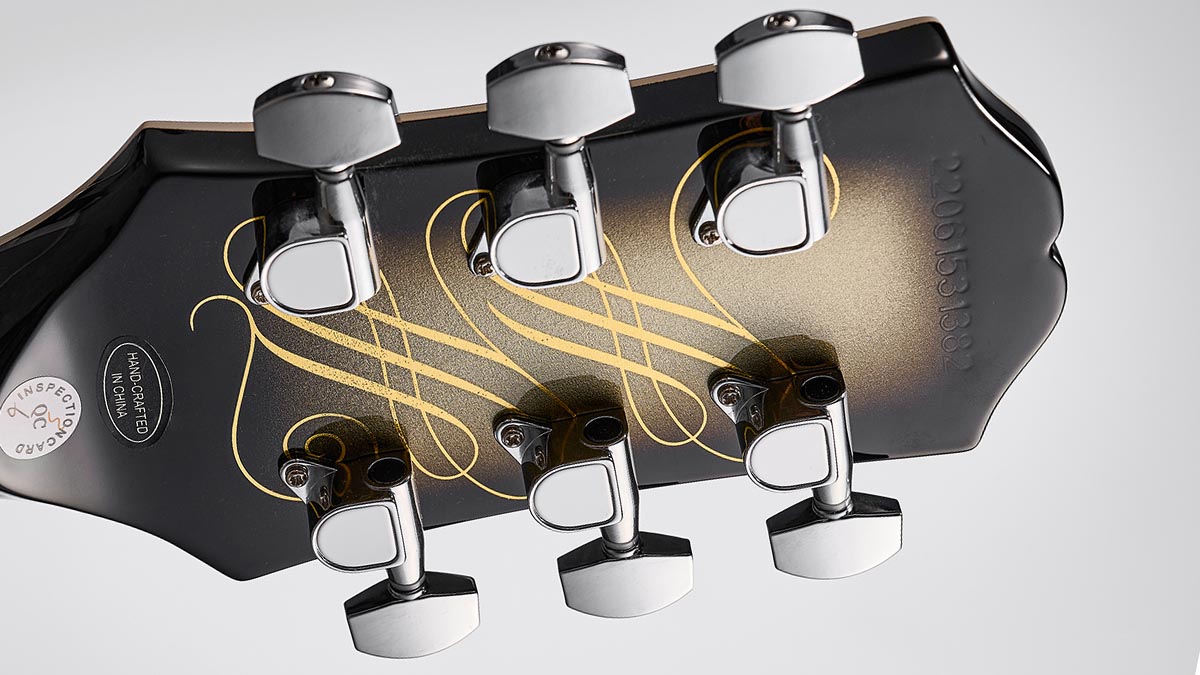
Given his background in visual arts, with credits for the makeup and special effects on blockbuster films like Jurassic Park, Batman Returns and Terminator 2: Judgement Day long before guitar stardom beckoned in Tool, the recent batch of Adam Jones signature guitars under a new partnership with Gibson were never going to be run-of-the-mill.
In 2020, the American brand unveiled its top-end Custom Shop recreation of his prized 1979 Les Paul Custom, which came with a headstock mirror and personalised graphic – 79 of which were aged by the Murphy Lab before being signed and numbered by the guitarist himself.
Last year’s Standard model featured a similar graphic and personalised truss rod cover, though interestingly it’s the more affordable interpretations under Epiphone that seem to house more in terms of features – with a choice of seven curated artworks across the back of the body, each variation limited to 800 units worldwide.
This second instalment in the Adam Jones Art Collection details Frank Frazetta painting The Berserker in all its glory and stands as one of the most unbelievably eye-popping designs ever to be manufactured by the Gibson budget brand.
The piece had been created by the American fantasy artist in 1968 for the cover of paperback novel Conan The Conqueror and Jones is one of many high-profile fans – the original painting currently owned by none other than Metallica guitarist Kirk Hammett.

There’s also additional artwork by artist Korin Faught on the back of the headstock, PosiLock strap buttons as per Customs of this era and a Protector hardshell case that harks back to the Gibson chainsaws of yesteryear.
Perhaps it’s the pickups that are the biggest talking point here: a reverse-mounted humbucker in the neck just like the guitarist’s 1979 original, a move which Jones revealed had been inspired by Melvins frontman Buzz Osborne “for a different polarity and sound”, and a passive ceramic-powered Seymour Duncan Distortion in the bridge which packs a whopping 16.6k DC resistance.

Given that the Gibson Standard version retails for over twice as much and doesn’t come with his bridge pickup of choice, its inclusion on the Epiphone model is certainly a big talking point.
The excitement doesn’t end there either, much like the guitar that has almost singlehandedly soundtracked Jones’ career, these reissues feature a three-piece maple neck with a Norlin-era volute.
At 9.9lbs this review model isn’t exactly lightweight, though it rightfully sits closer to the notoriously heavy 200 or so limited-run Silverbursts produced between 1978 and 1982.
Of course, none of this means anything if the guitar doesn’t feel, play or respond particularly well and in this case we have to say we’re huge fans of what the headline-stealing collaboration has yielded. Even before being plugged in, our sample rings loud and proud, with brightness and definition in abundance from the pairing of a maple neck with an ebony fingerboard.

Once amped up, these vibrations are articulated very well indeed, with the neck pickup’s warmth providing a well-matched contrast to the high-power snarl of the Duncan Distortion in the bridge – which, by the way, replicates the brain-simmering sounds of Ticks & Leeches, Jambi and Pneuma to a tee, as well as handling the less metallic tones from the quartet’s early years.
And that’s not all – though it undoubtedly lives up to its Berserker graphic in terms of firepower, this is a guitar that can cover a lot of ground well, from punchy cleans that could work in just about any jazz or pop context to earthy blues and beyond. Bearing in mind that Tool use clean sounds from time to time, perhaps most notably on tracks like Lateralus, Culling Voices and Right In Two, it makes perfect sense that these kinds of areas haven’t been overlooked.

As for playability, the custom Rounded C neck profile sits on the thicker side but still feels easy to get to grips with whether you’re playing riffs down below or leads up top – and in any case, makes you feel like you’re holding a real deal vintage Silverburst.
When compared to our late-’60s Gibson Les Paul Custom, there’s an unmistakable snappiness to this Jones signature, most likely from maple being used for the neck instead of mahogany and the boosted treble frequencies courtesy of the bridge pickup.
All in all, to say we’re impressed would be an understatement. Aesthetically and tonally, this could easily be the finest Les Paul ever produced by Epiphone.

Specs

- PRICE: $1,299 / £1,149
- ORIGIN: China
- BODY: Mahogany with a maple top
- NECK: Three-piece bound maple with volute
- SCALE: 628mm (24.75”)
- FINGERBOARD: Ebony
- FRETS: 22
- PICKUPS: Reverse-mounted Epiphone Probucker Custom (neck) and Seymour Duncan Distortion (bridge)
- CONTROLS: Individual pickup volume and tone controls, 3-way toggle pickup selector switch, CTS Potentiometers, Orange Drop Capacitors
- HARDWARE: Epiphone LockTone Tune-O-Matic bridge, Vintage-style Chrome tuners, PosiLock strap buttons
- FINISH: Antique Silverburst
- CONTACT: Epiphone







